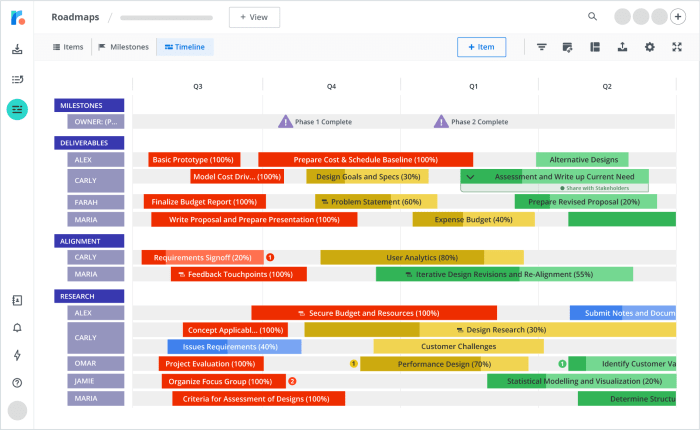Project Roadmap Examples A Comprehensive Guide
Project roadmaps are crucial for navigating the complexities of any undertaking, from software development to healthcare initiatives. This guide delves into the intricacies of project roadmaps, exploring diverse examples across various industries. Understanding these examples empowers stakeholders to craft effective strategies for achieving project goals.
From defining the foundational elements to visualizing progress, this exploration will cover a wide spectrum of methodologies. This includes different roadmap types, creation methods, and essential best practices, ultimately equipping readers with a practical toolkit for successful project management.
Introduction to Project Roadmaps
Project roadmaps are strategic planning tools that provide a high-level view of a project’s journey, outlining key milestones, timelines, and anticipated outcomes. They serve as a vital communication tool for stakeholders, ensuring everyone understands the project’s vision, objectives, and progress.
Definition of a Project Roadmap
A project roadmap is a visual representation of a project’s plan, detailing the key activities, phases, and deliverables. It’s a high-level view of the project, focusing on strategic direction rather than detailed execution. It communicates the project’s long-term vision and the steps needed to achieve it.
Importance of Project Roadmaps

- Improved Communication: Roadmaps clearly communicate the project’s objectives, timelines, and dependencies to stakeholders, fostering shared understanding and alignment.
- Enhanced Stakeholder Engagement: By outlining the project’s path, roadmaps keep stakeholders informed and engaged, promoting buy-in and reducing potential conflicts.
- Strategic Alignment: Roadmaps help ensure the project aligns with overall business goals and strategies, maximizing its impact and contribution.
- Risk Management: Identifying potential risks and dependencies early in the roadmap process allows for proactive mitigation strategies.
Common Reasons for Using Project Roadmaps
- Planning and Strategy: Roadmaps help in planning the project, outlining the steps, resources, and timelines needed.
- Decision Making: They provide a clear framework for decision-making, focusing on strategic choices and trade-offs.
- Resource Allocation: Roadmaps assist in allocating resources effectively by showing the resource requirements for each phase.
- Stakeholder Management: Roadmaps facilitate communication and engagement with stakeholders, keeping them informed about progress and potential roadblocks.
Key Components of a Project Roadmap
- Vision and Objectives: Clearly defined vision and objectives that guide the project.
- Timeline: A visual representation of the project’s timeline, including key milestones and deadlines.
- Milestones: Key events that mark progress and completion of specific phases.
- Dependencies: Identification of dependencies between tasks and activities to avoid conflicts and delays.
- Resources: Allocation of resources (personnel, budget, tools) required for each phase.
Example of a Project Roadmap
Consider a hypothetical project to develop a new mobile application. The roadmap would detail the various phases: planning, design, development, testing, deployment, and maintenance. Each phase would have specific milestones and deadlines. Resources like developers, designers, and testers would be allocated to each phase. Visual representation of the roadmap would show the timeline with milestones and tasks clearly defined.
Types of Project Roadmaps
Project roadmaps can be categorized based on factors like project size, complexity, and industry. Different types of roadmaps address the specific needs of various projects.
Categorization of Project Roadmaps
Project roadmaps can be categorized based on project size, complexity, and industry. For instance, a roadmap for a small, internal project might differ in structure from a large, complex project impacting several departments.
Roadmap Approaches and Examples
| Type | Description | Key Features |
|---|---|---|
| Agile Roadmap | Focuses on iterative development and frequent feedback. | Short sprints, frequent releases, adaptive planning. |
| Waterfall Roadmap | Sequential approach with distinct phases. | Well-defined stages, detailed documentation, rigid structure. |
| Product Roadmap | Artikels the product’s evolution over time. | Focuses on features, releases, and user needs. |
Elements of a Successful Project Roadmap
A successful project roadmap is more than just a visual representation; it’s a living document that reflects the project’s evolution and provides a framework for continuous improvement.


